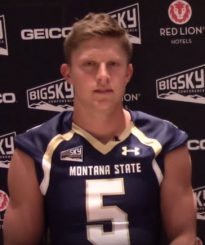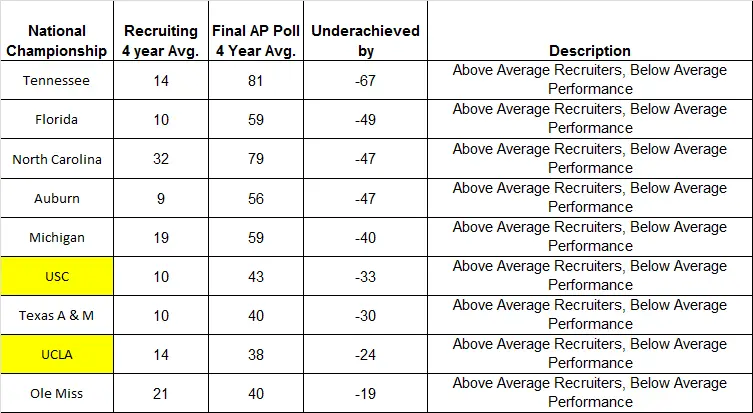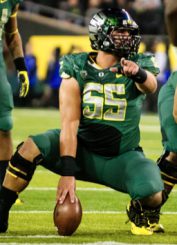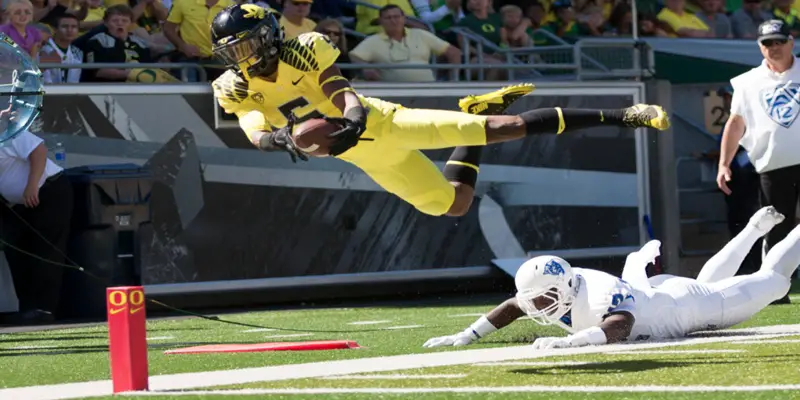It didn’t start with Moneyball, but the book, and movie starring Brad Pitt, about Major League Baseball’s Oakland A’s certainly shined a deserving spotlight on the relationship between statistics, math and winning.
Now is a great time of year to find some interesting college football pieces; for example, a recent article listed the college football programs with the most wins since 2010. (Alabama is No. 1) Most everyone would guess that, but few outside the Oregon Territory knew that Oregon is the second winningest major college football program since 2010.
Here’s a quality piece from ESPN’s Ted Miller that compares Pac-12 schools and who gets the most out of their recruiting class. It’s a brief, but telling, article that relates a story many knowledgeable college football fans thought to be true – and now see legitimized.
The analysis in this collaborative effort is more detailed as it scrutinizes the entire college football landscape and compares/contrasts recruiting rankings and every team that has averaged a top 25 finish over the last four years.

FishDuck.com recruiting guru, Jason Fowler.
Question: Was Oregon’s 28th-ranked recruiting class in the nation a sign that Oregon is on the way down?
Answer: “Helf, no.”
In fact, if history really does repeat itself, the Comparative Recruiting Index (CRI), makes a statistically relevant argument that Oregon has gotten exactly what it needed over the last four years and will be in the discussion for the college football playoff again.
This index is a FishDuck.com creation from my (Mike Ostrom) work and FishDuck.com Recruiting Analyst Jason Fowler, who researched the data and crunched the numbers for our benefit.
The CRI calculates a team’s average national recruiting class over the last four years and compares that with the team’s final AP ranking during that same four-year time frame. The CRI then breaks teams into two groups. Tier 1’s average, a final AP ranking between 1st and 10th and Tier 2’s ranking have an 11-20th average AP poll finish since 2013.
After evaluating all Division 1 programs who have spent time in the top 25 over the last four years, the Oregon Ducks are the #1 ranked CRI team in the nation over the last four years. Oregon has finished in the top 10 with what recruiting analysts have said is the 19th-best recruiting classes since 2013.
So does that make Oregon below average recruiters, or above average coaches? The fact that the Ducks’ final rankings over the last four years is +11 when compared to recruiting indicates that Oregon is getting the most from its players.
Other than Oregon, Clemson is the only other team in the nation to average a top 10 AP finish over the last four seasons and overachieve their recruiting ranking. The Tigers have the second-best +/- when you compare that ranking with the recruits they bring in. The Tigers are +4 over the past four years because their final AP ranking averages 9th in the nation, and their recruiting ranking places them 13th.
As Fowler quipped, “Statistically speaking, this is the Oregon way.”
To get a good idea of what’s coming up in 2016 and beyond, it’s important to look at the past. If you analyze the years prior to the Ducks playing for a share of the National Championship in 2001-02 and every four year period prior to Oregon playing in the Championship game in 2010-11 and 2014-15, you’ll see Oregon typically averages somewhere close to the 20th-best recruiting class in the nation according to Rivals, ESPN, etc. In other words, Oregon’s coaching staff does more with a very good recruiting class than other schools do with higher-ranked classes.
FishDuck.com Sports Reporter Sarah Greenlaw spoke with Oregon coach Mark Helfrich about this, and although everyone wants players who are big, fast and strong, Oregon’s recruiting process appears to be more granular than most.
“We just try to do as much research as we can and that’s a never ending deal,” says Helfrich. “As far as trying to do background checks, try to get to people that don’t have a vested interest in the guy as a player … but sometimes it’s the custodian or the secretary that gives you the truth about a guy.”
Helfrich will go on to tell you that this forensic look at players leads to many 4-star rated players not getting Oregon offers, and some 2-3 stars players getting a deeper evaluation and possibly a scholarship offer.
Is there anything wrong with averaging a top 10 recruiting class four years in a row? Absolutely not, but Oregon has never averaged that over a four year period – not Chip Kelly, Mike Belotti, Rich Brooks, Don Reid, Dick Enright, JerryFrei, Len Casanova - nobody.

Dakota has the guns for running …
In reality, Oregon’s 2016 recruiting was better than 28th because most recruiting services don’t count senior transfers such as QB Dakota Prukop and 6-7, 280 lb. offensive lineman Zac Morgan. If you add in those likely impact players (think Matt Hegarty and Vernon Adams from last season), Prukop and Morgan would launch Oregon closer to the #20 recruiting class in 2016. If you’re not sure how good Prukop is, check out the other schools who wanted him to be a one-year impact player. Nick Saban called. Prukop said, “No, thank you.”
You think having graduate transfers on the roster is a bad idea? Did you see who was playing receiver for Alabama when they won the National Championship last season? Answer: Former Oregon State Beaver Richard Mullaney. And it went so well Alabama did it again this year to replace Mullaney.
The point is two-fold:
- Question No. 1: When has Oregon ever consistently finished a four-year period with a top 10 recruiting class? Answer: Never
- Question No. 2: How do previous Oregon recruiting classes that led to National Championship appearances compare with what we’ve seen the last four years?
Answer: Oregon’s recruiting classes over the most recent four years have been slightly better.
So does that mean an Oregon win in the National Championship game instead of playing in the National Championship game? That’s up to the coaches and players and unfortunately has little to do with which lucky Oregon Ducks shirt I decide to wear on game day, or on which couch I sit on in our living room when watching the game.
Tier 2 Analysis: College Football teams that have averaged an 11-20th finish in the final AP poll since 2013.
There are three schools who are doing significantly more with less in this grouping. The team with the best +/- is Wisconsin. For those of you who know a thing or two about Badger country and their higher than normal academic standards, you know it’s not easy to matriculate at Wisconsin.
This makes recruiting that much harder, but Badger coaches have significantly outperformed their recruiting rankings by a +23. Baylor at +17 and Stanford at +12 also earn a much higher end of the season AP ranking than their recruiting rankings might suggest.
National Championship Contenders
How do things look for teams who are winning National Championships? How do their four-year recruiting rankings compare?
Let’s start with the Haves. Since 2009 these four teams have won all of the National Championships: Alabama (4) and Auburn, Florida State and Ohio State have one each.
If you look at the CRI, every one of these teams has averaged a top 10 recruiting class or better over the last four years.
As you might guess, Alabama has averaged the #1 recruiting class, and it makes sense that the Crimson Tide has the most National titles. Ohio State checks in at 5th, Florida State is 6th and Auburn has averaged the 9th-best recruiting class over the last four years.
What’s the point? If you’re going to win the National Championship it helps – it helps a lot - to have some of the best players in the nation. Oregon has averaged the 19th-best recruiting class over the last four years, so are they doomed to Sun Bowl appearances for the next decade? Or are they primed to play for national championships like they did in 2010 and 2014?
Answer: The recruiting that Oregon has averaged over the last four years is better than what they had the four years prior to the 2010 and 2014 seasons. In short, Oregon has what it needs.
Doing Less With More
Who does less with more? In other words, which teams bring in great recruiting classes but underachieve significantly on the field? I’m not naming any names, but I’ll give you the initials of two of the teams who are the biggest under-achievers in college football - USC and UCLA - and the numbers are staggering.
Below is a list of teams whose cupboards are full of 4-star talent but the wins aren’t following.
Tennessee, Florida, North Carolina and Michigan all bring in big-time, 4- and 5-star players, but over the last four years their average AP ranking is nowhere close to the top 25.
In the Pac-12, USC and UCLA talk a good game to recruits, but don’t deliver on the field. The Trojans and Bruins have combined to average the 12th-best recruiting classes over the last four years, but they are 43rd and 38th, respectively, in the final AP polls.

Come to Oregon as a 3-star athlete, and become an all-American (Hroniss Grasu).
I doubt any recruit has ever considered the following, but if you’re a 4- or 5-star guy and you’re deciding between Oregon and USC, and football is your top priority, it’s a no-brainer – go to Oregon! You’ll win a Pac-12 title, possibly more than one, and likely compete for a National Championship.
If you want to be overrated and finish 43rd in the nation and lose to Oregon three times, go to USC.
If you want warm weather nearly year round, go to USC.
If you appreciate a wide variety of tie-dyed shirts and want to play in a college football playoff, go to Oregon!
So when Oregon delivers a recruiting class that’s ranked about 20th nationally, know that this is the exact formula Oregon has used to become the second winningest program in college football since 2010. Like it or not, this is the road map. This is The Oregon Trail of recruiting that leads to The Oregon Way.
Many Duck fans are concerned about 4-star running back Vavae Malepeai flipping from Oregon to USC in February. No one likes losing a 4-star athelete the night before signing day, but realize that the RB position may be the easiest position to recruit to if you’re a Duck coach.
Think back … way back. When was the last time Oregon was in need of a high end running back? … keep going, keep going … maybe when Choo Choo Young was on the roster?
For Oregon, finding Tier 1 running backs is like trying to find good clam chowder in Newport. It is not that hard. Here’s the Chowder/Running Back analysis.

The home of Oregon running backs … too.
Mo’s on Bay Blvd. in Newport represents the State of California. Lots of great chowder at Mo’s, lots of great running back in California.
The Chowder Bowl on Beach Drive is the state of Texas in this analogy. The Chowder Bowl is a can’t-miss just like most Texas high school recruits have been impact players for the Ducks, with the rare exception (rhymes with Cake Beastrunk).
If the Ducks need running backs and Oregon and Washington are barren, there are plenty in California, Texas, Georgia and Florida. Loville, LaMike, Moore, Morris, Blount, Barner, Smith, Stewart … Oregon gets what they need at RB and most make it to the NFL.
Side Bar: Speaking of Onterrio Smith, did you know a Minnesota bar owner paid $750 for Smith’s Whizzinator? You can’t make this stuff up. I wonder how the bar owner explained that one to his wife.
“Hey honey, I know I gave you a hard time about that $250 hair color and style the other day, but you’ll never guess what I won at an auction for $750.”
Now, when Oregon loses out on a Tier 1 defensive lineman or linebacker, that’s a different story. That is significant, which leads me to a semi-related topic.
Rabbit Trail – Shaq Thompson Rant
This is a bit of a stretch, but linebacker Shaq Thompson (Carolina Panthers), may have cost Oregon two national championships.
You might remember Thompson was seriously considering Oregon before he finally decided on Washington … What was Thompson thinking choosing Washington over Oregon?
While at UW, Thompson’s teams went a pedestrian 14-13 in conference games and lost all three games to Oregon. Thompson’s lone bowl win with Steve Sarkisian was the 2013 Fight Hunger Bowl. Thompson passed on Alabama and Oregon for Washington & Sarkisian? Really … Washington? And say what you will about Sarkisian, but the dude had his recruiting moments.
This whole Thompson thing is significant because had Thompson gone to Oregon in 2012, he could have been a difference maker and enabled Oregon to beat Stanford at Autzen. With a win over the Cardinal, Oregon goes on to play and throttle Notre Dame for the 2012-13 National Championship.
During the 2014-15 National Championship, Thompson could have plugged some gaps and lit up Ezekiel Elliot, and who knows what would have happened in the second half of that game, but I digress.

Kaumatule is the defensive foundation for the future
The point is, when Oregon has been a whisker away from the National Championship, the greatest need has been defense and Oregon currently has as many 4-stars on the roster as they ever have, even a 5-star with Canton Kaumatule.
So I conclude with this: If you want to know how good a system is, the Comparative Recruiting Index can be a good indicator. What you’ll find is Oregon outperforms their recruiting classes significantly, +11 over the last four years. No other team in the nation that consistently finishes in the top 10 and rates that high of a +/-. Credit the coaches and players, and expect more of the same.
When it comes to top 10 recruiting classes, if Oregon starts landing them consistently, great. If not, that’s okay. Great recruits don’t equal success on the field.
USC is an example of a program that consistently delivers a top 10 recruiting classes and has underachieved just as consistently. The Trojans have lost four games or more 6 of the last 7 seasons and USC has had four head coaches since the start of the 2013 season.
When it comes to Oregon’s 2016 recruiting class, it may not have that “it” factor. “It” is that special something that very few people have, i.e. Joey Harrington’s leadership, the wiggle and breakaway speed of De’Anthony Thomas and that ability to deliver a pad-cracking hit that brings ooos and ahhhs from the crowd like Thom Kaumeyer did.
That “it” factor for Oregon’s most recent recruiting class could be the fact that every one of their signed recruits was a captain on their respective team. Oregon got what it needed in 2016 … not everything it wanted, but everything it needed. Recruiting rankings serve a purpose, but I’ll take above-average Oregon recruits and above-average Duck coaches every time.
(A special thank you to Recruiting Guru Jason Fowler, for his work creating a unique index that FishDuck.com writers can refer to for measurement in the years ahead)
Top photo by Gary Breedlove
Related Articles:

Mike Ostrom is a 1989 Oregon Graduate (Journalism Major) He worked on air as the TV Sports Director for a CBS affiliate for many years and has free lanced for ESPN, Fox and other media entities. He has covered everything from high school football to the Superbowl. Mike lives in Dallas, TX where he and his wife raised five children. His full time job is in the Google/Social Media advertising space. The Ostroms also run a small ministry that provides soccer balls for orphans and underprivileged kids around the world.

